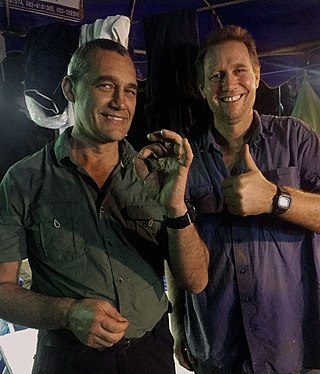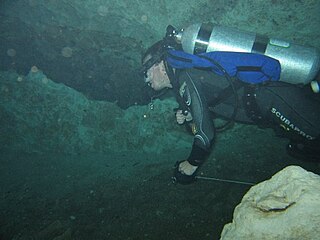
Wookey Hole Caves are a series of limestone caverns, a show cave and tourist attraction in the village of Wookey Hole on the southern edge of the Mendip Hills near Wells in Somerset, England. The River Axe flows through the cave. It is a Site of Special Scientific Interest (SSSI) for both biological and geological reasons. Wookey Hole cave is a "solutional cave", one that is formed by a process of weathering in which the natural acid in groundwater dissolves the rocks. Some water originates as rain that flows into streams on impervious rocks on the plateau before sinking at the limestone boundary into cave systems such as Swildon's Hole, Eastwater Cavern and St Cuthbert's Swallet; the rest is rain that percolates directly through the limestone. The temperature in the caves is a constant 11 °C (52 °F).

Nelson is a New Zealand city on the eastern shores of Tasman Bay at the top of the South Island. It is the oldest city in the South Island and the second-oldest settled city in New Zealand; it was established in 1841 and became a city by royal charter in 1858.

Tasman District is a local government district in the northwest of the South Island of New Zealand. It borders the Canterbury Region, West Coast Region, Marlborough Region and Nelson City. It is administered by the Tasman District Council, a unitary authority, which sits at Richmond, with community boards serving outlying communities in Motueka and Golden Bay / Mohua. The city of Nelson has its own unitary authority separate from Tasman District, and together they comprise a single region in some contexts, but not for local government functions or resource management (planning) functions.

Kahurangi National Park in the northwest of the South Island of New Zealand is the second largest of the thirteen national parks of New Zealand. It was gazetted in 1996 and covers 5,193 km2 (2,005 sq mi), ranging from the Buller River near Murchison in the south, to the base of Farewell Spit in Golden Bay in the north. The park has no single dominant landform, but includes an unusually wide variety of landscapes, including mountain ranges, rivers, gorges, raised peneplains and karst features such as caves and arches. Many of the landforms within the park are considered to be nationally or internationally significant.

Motueka is a town in the South Island of New Zealand, close to the mouth of the Motueka River on the western shore of Tasman Bay. It is the second largest in the Tasman Region, with a population of 8,320 as of June 2023.

The Motueka River is located in the north of the South Island of New Zealand and is a popular tourist destination for watersports and fishing. The Motueka flows 116 kilometres (72 mi) from the mountains 40 km west of the city of Nelson in the southeast of the catchment and flows north to the Tasman Bay.

Tapawera is a small town in the Tasman District of New Zealand's South Island. It is located 76 km southwest of Nelson and 48 km southeast of Motueka. It is situated on the Motueka Valley Highway by the banks of the Motueka River.

The Riuwaka River, formerly known as the Riwaka River, is located in the Nelson region in the northwest of New Zealand's South Island. It flows for 20 kilometres, entering Tasman Bay close to the town of Riwaka, 10 kilometres north of Motueka.

Riwaka is a small settlement in the Tasman District of New Zealand's South Island. It lies beside Tasman Bay / Te Tai-o-Aorere, five kilometres north of Motueka, and close to the mouth of the Riuwaka River. The land where the town is based was a swamp known as Tureauraki. Europeans first settled in Riwaka in May 1842. The Riwaka economy has been based around growing tobacco and hops.

Nettlebed Cave is a limestone cave located in the Mount Arthur region of the northwest South Island of New Zealand. The presence of ongaonga, an endemic tree nettle, near the bottom entrance gives the cave its name.

Ngātīmoti or Ngatimoti is a town near Motueka in New Zealand's South Island.

Caving in New Zealand is an established hobby as well as being a part of commercial tourism.
David Apperley is an Australian technical diver and cave explorer. Apperley holds instructor levels in cave diving, Deep Mixed Gas Diving and Deep Closed Circuit Rebreather Diving and was the expedition co-ordinator for the Pearse Resurgence Project 1996–2003. He was the project leader on the Royal Mail Ship Niagara 2003 Survey Project, which involved the organization and planning of putting some of the world's most experienced divers onto the 130-metre-deep Niagara wreck site, off the North Island of New Zealand.

Craig Challen, SC is an Australian technical diver and cave explorer who played a substantial role in the Tham Luang cave rescue. He was the recipient of the Oztek 2009 Diver of the Year award for his services to caving, and was joint winner of the 2019 Australian of the Year.
Talley's Group Limited is a privately owned, New Zealand-based agribusiness company that provides seafood, vegetable and dairy products. Talley's was established in 1936 in Motueka by Ivan Peter Talijancich as a manufacturer of seafood, and has since grown into one of the largest agribusiness companies in New Zealand.
Ann Boyce was a New Zealand founding mother and herbalist. She was born Ann Cave in Sydney, Australia, on 20 November 1827. In 1837 she came to Port Underwood in Marlborough, New Zealand, with her family. She married William Boyce when she was 16 or less, and they lived in the Nelson area, and later Motueka. She had 13 children. Boyce had close contact with Māori people from the time she came to New Zealand. In Motueka, she was known as a herbalist especially knowledgeable about the medicinal use of plants, and provided medical assistance to Māori.

Richard Harris SC, OAM, is an Australian anaesthetist and cave diver who is currently the Lieutenant Governor of South Australia. Harris is best known for having played a crucial role in the Tham Luang cave rescue. He and Craig Challen were jointly awarded 2019 Australian of the Year as a result of that rescue. Harris was appointed as South Australia's Lieutenant-Governor in 2024, and was sworn in on 9 February 2024.

Cave Creek / Kotihotiho is a small river within Paparoa National Park, on the West Coast of New Zealand's South Island.

Cave diving is underwater diving in water-filled caves. The equipment used varies depending on the circumstances, and ranges from breath hold to surface supplied, but almost all cave diving is done using scuba equipment, often in specialised configurations with redundancies such as sidemount or backmounted twinset. Recreational cave diving is generally considered to be a type of technical diving due to the lack of a free surface during large parts of the dive, and often involves planned decompression stops. A distinction is made by recreational diver training agencies between cave diving and cavern diving, where cavern diving is deemed to be diving in those parts of a cave where the exit to open water can be seen by natural light. An arbitrary distance limit to the open water surface may also be specified. Despite the risks, water-filled caves attract scuba divers, cavers, and speleologists due to their often unexplored nature, and present divers with a technical diving challenge.
The Wharepapa / Arthur Range is a mountain range partially marking the boundary between the Tasman District and West Coast Region of New Zealand's South Island. The range is at the eastern extent of the Tasman Mountains which make up much of the island's northwest, making it easily visible from across the low-lying Waimea Plains further to the east. The range's location and its many uses make it a significant site for local Māori, including the iwi of Te Ātiawa and Ngāti Rārua. This includes the prominent peaks of Mount Arthur and Pukeone / Mount Campbell, which both hold mana in their own right and have become part of the identity of the aforementioned iwi.

















